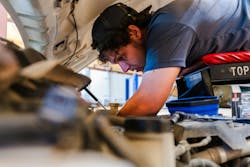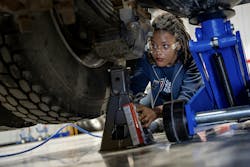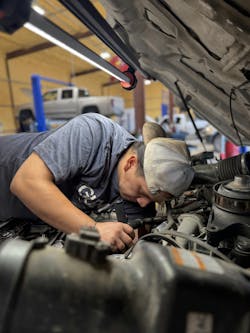Sorting out technician pay and finding a fair compromise
If it always worked out perfectly, shops would just pay technicians a flat rate, where pay is dependent on billable hours. This scenario incentivizes technicians to be more productive; they only earn when the shop is getting paid. Furthermore, it promotes technician efficiency. If a tech can get a four-hour job done in three hours, they still get paid for all four. Super efficient and proficient technicians can make a lot of money.
That’s great for the top techs in the shop, but less appealing for everyone else. That’s a reason flat rate seems to be falling out of favor versus set hourly wages.
“Very few shops are doing flat rate anymore, and it’s almost nonexistent in heavy duty,” said Peter Cooper, CEO of Ascend Consulting and a brand ambassador for Fullbay shop management software. “The main reason why is that most shops won’t be able to get buy-in from the employees.”
Wages by the numbers
- $30 PER HOUR: The median technician pay in Q4 of 2024
- 3.4% YOY: How much technician pay grew throughout 2024
- $32 PER HOUR: The hourly technician rate grew from $31 to $32 from 2023-2024
Source: Fullbay’s 2024-2025 State of Heavy Duty Repair Report
- 64% of diesel technicians prefer hourly or salaried pay
- 5% of diesel technicians prefer traditional flat-rate pay
Source: WrenchWay’s Voice of Technician Report
Industry veteran Ken Eggen believes flat rate can still work under the right circumstances. It just takes the right technicians with the right experience and mindset. It’s also helpful when the SRTs (standard repair times) are embraced with open arms.
“Years ago when I was helping manage a 1,000-vehicle fleet, we looked at average repair times across our three shops to develop our own internal repair times,” said Eggen, who today is COO at Wolf River Express, a transportation company with offices in Tennessee, Ohio, and Illinois. Eggen also has a maintenance consulting business, K.M.E. Services. “We got really good buy-in because the technicians felt like they participated in the creation of those standard job times. The high achievement-minded technicians get what flat rate can do.”
In Taylor, Texas, Guzman Automotive, which services consumer and Classes 1-6 commercial vehicles, has been able to make flat rate work. The two-year-old shop is co-owned by longtime auto shop manager James Guzman, company CEO, and his son, Joe Gonzales, company president, who treat their techs like family. In this structure, the older, more experienced A and B techs are flat rate, while the C techs make an hourly wage.
“Every 90 days, we are looking at what our C-level apprentice technicians have been producing, what they’ve learned, and which certifications they’re pursuing,” Gonzales said. “We want everybody striving for that next tier. That’s why we also encourage our C-level apprentices to help out the A-level master technicians.”
Not every technician is built the same way, though, which is why many shops have found hybrid pay structures to be very effective. By combining an hourly wage with some form of incentivized compensation, shops can provide predictability while also offering opportunity, which is an effective way to drive productivity and profitability.
Why flat rate fell flat
One of the downsides of flat rate is that a technician doesn’t get paid unless there’s work to be had. That can lead to income volatility, especially during slow periods or when engaged in highly complex jobs. Not every technician will be accepting of this. In fact, Cooper said most won’t—particularly when working for the typical independent repair shop.
“If I were a technician looking for a job, I just don’t know that I would trust a small, independent shop to keep me busy,” Cooper related. “Flat rate is just too risky for most technicians.”
Flat rate also presents some potential downsides from the shop’s perspective. Since emphasis is on speed, shops could see an uptick in misdiagnosis and comebacks. At a dealership or independent repair shop, a technician has to eat that comeback time, so it sort of polices itself. But for a fleet’s internal maintenance department, the manager often needs to do quite a bit of policing.
“In a fleet shop, there needs to be consistent measuring, monitoring, and coaching of the technicians to remind them that they need to do the jobs the right way and not get in too much of a hurry,” Eggen said.
Another potential downside of paying flat rate is that morale could suffer if some technicians feel like others are getting all the good jobs. Morale could also take a hit if technicians feel like the SRTs are unrealistic. That’s why Eggen said developing your own times is not a bad idea. If that isn’t practical, rely on SRTs from a reputable, independent source such as the Technology & Maintenance Council (TMC), MOTOR, ALLDATA, Mitchell 1, Diesel Laptops, and/or others.
“Technicians also have to be given the right tools in the right place so they can do their jobs the right way,” Eggen added. “The parts room is a huge factor. If the right parts aren’t in inventory, how do you expect the technician to keep moving and get paid?”
The role of the service writer is also important. The service writer, Eggen pointed out, is typically the first person to have a conversation with the driver. “The writer must do a good initial diagnosis to get that express assessment done correctly and written up clearly,” Eggen said. “Then the technician can get a good jump on what they need to do.”
Could all of this lead to a shop culture where support staff develop animosity for the technicians? It certainly could if things were left to fester.
Guzman Auto’s Gonzales noted a time when a service advisor mistyped labor times and then had an hourly C-level tech perform the work to decrease the labor cost, instead of communicating the mistake to the customer.
“This frustrated the A technician who completed the diagnosis because it would short his labor time,” Gonzales said. Of course, the shop owner quickly addressed this, telling the advisor he would have to pay for mistakes like that out of his own pocket in the future, and not take money from the tech.
“That’s not a fun conversation to have, but you’re taking food off a hardworking man’s table when you do that,” Gonzales asserted.
Another thing to watch is having flat-rate techs perform jobs outside of their primary role of producing revenue, such as trying to find an elusive repair part.
“Why on earth would a shop have its technicians running around chasing parts?” Cooper asked. “Techs shouldn’t be doing anything that takes a wrench out of their hand, and everyone needs to understand that.”
That’s not to suggest that a flat-rate pay structure is the only way to achieve maximum productivity. When you think about the main objectives of paying techs flat rate in the first place, hybrid compensation structures also make a lot of sense.
6 reasons why techs hate flat rate
1. Inconsistent amount of work leads to inconsistent and unpredictable paychecks
2. Morale goes down when some techs feel like others are getting all the good job
3. There’s a feeling that SRTs are unrealistic and unfair
4. Techs feel like they aren’t being set up for success with the right tools and overall work environment
5. Poor parts inventory management can slow techs down and impact their paychecks
6. Service writers don’t do a good job with their initial assessments, which causes techs to get off to a slow start
Get the best of both worlds with hybrid pay
“With a hybrid pay plan, you pay an hourly wage along with a production bonus,” Cooper explained. “That’s the best of both worlds because you’re incentivizing technicians to perform, but their base paycheck is also predictable.”
According to Zane Clark, director of technician relations at TechForce Foundation, hybrid pay plans can only be effective when roles and pay expectations are clearly defined. Additionally, there must be open communication regarding how work is assigned, performance must be consistently tracked, and technician feedback must be solicited so any necessary adjustments can be implemented.
“Ultimately, success hinges on mutual trust and aligning the pay structure with each technician’s strengths and motivations,” Clark said.
Success also hinges on how the shop as a whole will benefit. According to Cooper, it starts with determining what the shop can afford to pay its technicians. As a general rule, technician wages should be around 17-20% of a shop’s gross income. Fullbay’s “State of Heavy-Duty Repair” report suggests that the median shop labor rate is $134. So as an example, a shop charging $134 should be able to pay technicians anywhere from $22.78 to $26.80 per hour.
Cooper said a good threshold for kicking in premium pay is 70-75% efficiency. “If a technician is billing 30 hours a week, the shop is likely making money off of that technician,” Cooper said. “Once a technician hits 32 hours (80% efficiency), everything beyond that is typically profit.”
Vincent Myles, owner of Myles Truck Repair, worked with Cooper to develop a hybrid pay structure across his three diesel repair shops in Georgia. Technicians work a maximum of 40 hours a week. If they can bill 35 of those hours (87.5% efficiency), they get an extra $2 per hour for that week. The higher the efficiency rating, the higher the pay premium for the week. “Our tier system actually goes as high as making an extra $24 per hour on top of their hourly wage,” Myles pointed out.
It should be noted that Myles Truck Repair does have one technician who’s still on flat rate, and that’s because the technician has requested it. “He’s a very driven person who understands that flat rate can mean feast or famine,” Myles pointed out. That technician is a rarity though. Myles said 90% of techs have no interest in flat rate pay. He doesn’t think flat rate is in the best interest of the typical shop, either.
“We tried flat rate in the past and it really hurt us,” Myles related. “The techs had no feeling of stability from one week to the next. That led to more errors because they felt like they had to hurry to make a decent paycheck. With this hybrid system, our techs don’t feel like they have to work a ton of hours to make decent money. They make money and the shop makes money by being more efficient.”
The tiered system at Guzman Auto seems to alleviate some of this. Gonzales said the A-level techs get around $55 per flat hour, B-level techs get around $35 per flat hour, and C-level techs earn an hourly wage of $20 to $25 per hour. Leadership explains upon hiring why and how this system works to discourage animosity among the C-level techs who will routinely assist the A-level guys making more than double their pay.
Part of these junior techs’ compensation is that invaluable mentorship that will someday help them improve their SRTs and bill more hours in the day.
“The role of a C-level apprentice technician is clearly defined, and part of that role is gaining valuable on-the-job experience by helping our A-level master technicians,” Gonzales explained. “Our C-level techs realize how this will make them more valuable 12 months down the road. They also get a taste of what working on these bigger jobs is like, and how much money they could end up making if they got bumped up to flat rate. Now they want to learn and grow as quickly as humanly possible.”
This structure has also helped Guzman Automotive keep their A-level technicians in the game. As Gonzales explained, a lot of these experienced technicians are really sharp, but their bodies are wearing down faster than their minds. With assistance from the C-level apprentices, the older master technicians don’t have to worry about lifting heavy things and potentially getting injured.
C-level apprentices are incentivized in their own right. They often get an hourly premium for every hour beyond the 20 they bill. As for the B-level technicians, they are able to earn a solid flat rate while continuing to hone their skills and learn to become more efficient. They also see the opportunity to evolve to the A level, where they’ll be granted a “helper” so they can bill even more hours and make even more money. That provides a lot of motivation.
“This program has had a huge impact on productivity, profitability, and morale,” Gonzales said. “It eliminates the thinking that one tech is taking work away from another. Everyone is gaining from helping each other.”
Offering premium pay or bonuses based on efficiency and throughput is typically the most common way of incentivizing technicians. But it’s not the only way.
“In a fleet shop, it’s all about uptime,” Eggen said. “So standards and incentives around how long vehicles are in the shop, no comebacks, no worker comp injuries, attendance, etc. can feed into some really good incentive plans that could be paid on a quarterly basis. The fleet should identify upfront how much money is available and what needs to happen to earn the incentive. Then everybody in the shop can share equally. When it works correctly, the technicians all pull their weight and start to manage each other.”
How technicians really become “rich”
A healthy, predictable paycheck is certainly essential to recruiting and retaining technicians today. But it’s only one piece of the puzzle.
Think about a young person just starting their career. In fact, take another step back and think about why they even enrolled in a diesel program at a technical college in the first place. According to Tyler Rhodes, education manager at the Universal Technical Institute campus in Avondale, Arizona, many students were told they could make a good living as a diesel technician and would have an easy time landing a job.
“Beyond that, there isn’t a whole lot of thought that goes into how they are going to earn this great living,” Rhodes said.
To that point, most emerging technicians don’t really understand what flat rate is, according to Rhodes. But they do understand what being valued feels like.
“When I first got into the auto repair industry many years ago, there were no tool allowances or tuition reimbursements,” Rhodes said. “In today’s world, many employers are offering these types of things in some form, along with things like relocation allowances. Everyone is competing for the same technicians. In most cases, everybody knows what they need to be paying as a starting wage. So those other types of benefits can help.”
According to data presented in Fullbay’s report, two-thirds of shops offer health insurance and provide bonus opportunities for technicians, 59% provide some level of assistance for purchasing tools, 44% offer flexible scheduling, and 36% provide a matching 401k program.
Ready for one more statistic? The Fullbay report suggests that roughly two-thirds of technicians would prefer to stay right where they are. Given that, it’s really up to a shop to give technicians a reason to stay.
“We have to think past the binary idea that compensation is either hourly or flat rate,” TechForce Foundation’s Clark said. “The more systemic issue is how we elevate the technician profession by improving workplace culture, conditions, and total compensation. That means aligning the need for skilled labor with the needs of skilled labor—ensuring that techs are respected, supported, and inspired to stay and grow in the industry.”
About the Author

Gregg Wartgow
Gregg Wartgow is a freelancer who Fleet Maintenance has relied upon for many years, writing about virtually any trucking topic. He lives in Brodhead, Wisconsin.




